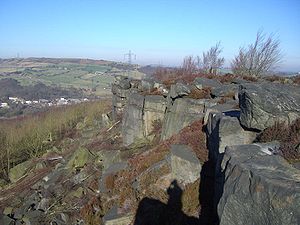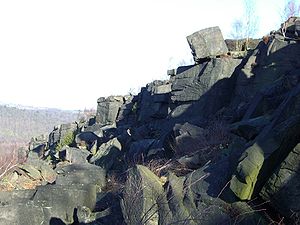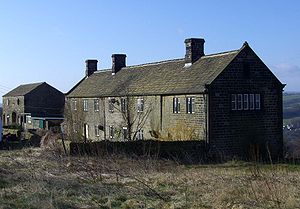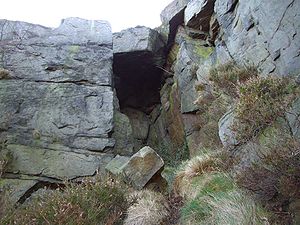
Wharncliffe Crags
Encyclopedia


Gritstone
Gritstone or Grit is a hard, coarse-grained, siliceous sandstone. This term is especially applied to such sandstones that are quarried for building material. British gritstone was used for millstones to mill flour, to grind wood into pulp for paper and for grindstones to sharpen blades. "Grit" is...
escarpment
Escarpment
An escarpment is a steep slope or long cliff that occurs from erosion or faulting and separates two relatively level areas of differing elevations.-Description and variants:...
or edge situated approximately 10 km (6 mi) north west of the city of Sheffield
Sheffield
Sheffield is a city and metropolitan borough of South Yorkshire, England. Its name derives from the River Sheaf, which runs through the city. Historically a part of the West Riding of Yorkshire, and with some of its southern suburbs annexed from Derbyshire, the city has grown from its largely...
in South Yorkshire
South Yorkshire
South Yorkshire is a metropolitan county in the Yorkshire and the Humber region of England. It has a population of 1.29 million. It consists of four metropolitan boroughs: Barnsley, Doncaster, Rotherham, and City of Sheffield...
, England
England
England is a country that is part of the United Kingdom. It shares land borders with Scotland to the north and Wales to the west; the Irish Sea is to the north west, the Celtic Sea to the south west, with the North Sea to the east and the English Channel to the south separating it from continental...
.
Overview
The edge which is characterised as a steep rock face for much of its four kilometre length runs from grid reference just east of the village of Deepcar in a roughly south easterly direction to grid reference just east of Wharncliffe Side. Wharncliffe Crags stand on the eastern side of the upper River Don valley at a height of around 250 metres above sea level with the highest spot height being 297 metres. Although set in a pleasant situation, the northern end of the crags are never far away from the buzz of civilisation with the noise of the nearby Stocksbridge bypass and A6102 road ever present, there are also two lines of electricity pylonElectricity pylon
A transmission tower is a tall structure, usually a steel lattice tower, used to support an overhead power line. They are used in high-voltage AC and DC systems, and come in a wide variety of shapes and sizes...
s which converge at the northern end of the crags. The escarpment was formed 320 million years ago in the Paleozoic
Paleozoic
The Paleozoic era is the earliest of three geologic eras of the Phanerozoic eon, spanning from roughly...
era.
History
The rocks at the north western end of Wharncliffe Crags have been quarried to produce Quern-stoneQuern-stone
Quern-stones are stone tools for hand grinding a wide variety of materials. They were used in pairs. The lower, stationary, stone is called a quern, whilst the upper, mobile, stone is called a handstone...
s as far back into history as the Iron Age
British Iron Age
The British Iron Age is a conventional name used in the archaeology of Great Britain, referring to the prehistoric and protohistoric phases of the Iron-Age culture of the main island and the smaller islands, typically excluding prehistoric Ireland, and which had an independent Iron Age culture of...
, continuing into the period of the Roman
Roman Empire
The Roman Empire was the post-Republican period of the ancient Roman civilization, characterised by an autocratic form of government and large territorial holdings in Europe and around the Mediterranean....
occupation of Britain. The name Wharncliffe actually evolved from the term “quern cliff”. The process of quern production has left behind considerable evidence in the area of the crags, including work flooring and trackways as well as many abandoned querns. In August 1996 an accidental heather fire burned away much of the vegetation over an area of 8 hectares, revealing many more quern-stones than had originally thought present. A survey by English Heritage
English Heritage
English Heritage . is an executive non-departmental public body of the British Government sponsored by the Department for Culture, Media and Sport...
in 2000 uncovered around 2300 stones in the 8 hectares area leading to the estimate that there could be around 8000 quern stones in the quarry area. The area of quern production has been declared a Scheduled Ancient Monument. Wharncliffe Lodge stands at the southern end of the crags and has fine views of the Ewden valley to the west. The present building dates from the 19th century and is the third lodge on the site with the original being built in 1510. The lodge has strong associations with Lady Mary Wortley Montagu
Lady Mary Wortley Montagu
The Lady Mary Wortley Montagu was an English aristocrat and writer. Montagu is today chiefly remembered for her letters, particularly her letters from Turkey, as wife to the British ambassador, which have been described by Billie Melman as “the very first example of a secular work by a woman about...
who resided there for short periods in the early 18th century. The floor of one of the rooms bears the inscription of Henry VIII’s
Henry VIII of England
Henry VIII was King of England from 21 April 1509 until his death. He was Lord, and later King, of Ireland, as well as continuing the nominal claim by the English monarchs to the Kingdom of France...
reign (1491-1547).
Geology and habitat
The geology of Wharncliffe Crags led to the area being designated a Site of Special Scientific InterestSite of Special Scientific Interest
A Site of Special Scientific Interest is a conservation designation denoting a protected area in the United Kingdom. SSSIs are the basic building block of site-based nature conservation legislation and most other legal nature/geological conservation designations in Great Britain are based upon...
in 1988. The geological features of the cliff face are of special interest showing the best available exposed example of the Wharncliffe Edge Rock Formation within the Pennines
Pennines
The Pennines are a low-rising mountain range, separating the North West of England from Yorkshire and the North East.Often described as the "backbone of England", they form a more-or-less continuous range stretching from the Peak District in Derbyshire, around the northern and eastern edges of...
and show two primary sandstone beds which were originally laid down as sediments from a meandering river. The downslope from the base of the cliff towards the Don valley is covered by the birch
Birch
Birch is a tree or shrub of the genus Betula , in the family Betulaceae, closely related to the beech/oak family, Fagaceae. The Betula genus contains 30–60 known taxa...
and oak
Oak
An oak is a tree or shrub in the genus Quercus , of which about 600 species exist. "Oak" may also appear in the names of species in related genera, notably Lithocarpus...
woodland of Wharncliffe woods which is owned by the Forestry Commission
Forestry Commission
The Forestry Commission is a non-ministerial government department responsible for forestry in Great Britain. Its mission is to protect and expand Britain's forests and woodlands and increase their value to society and the environment....
. The flat ground on the top of the crags is mostly carpeted with heather
Calluna
Calluna vulgaris is the sole species in the genus Calluna in the family Ericaceae. It is a low-growing perennial shrub growing to tall, or rarely to and taller, and is found widely in Europe and Asia Minor on acidic soils in open sunny situations and in moderate shade...
. The level terrain behind the central part of the crags is known as Wharncliffe Chase, this was part of a royal hunting park in the Middle Ages
Middle Ages
The Middle Ages is a periodization of European history from the 5th century to the 15th century. The Middle Ages follows the fall of the Western Roman Empire in 476 and precedes the Early Modern Era. It is the middle period of a three-period division of Western history: Classic, Medieval and Modern...
. More recently the chase was mined for Ganister
Ganister
A ganister is hard, fine-grained quartzose sandstone, or orthoquartzite, used in the manufacture of silica brick typically used to line furnaces...
which was used to produce furnace bricks for the local steel industry, there has also been small scale coal
Coal
Coal is a combustible black or brownish-black sedimentary rock usually occurring in rock strata in layers or veins called coal beds or coal seams. The harder forms, such as anthracite coal, can be regarded as metamorphic rock because of later exposure to elevated temperature and pressure...
mining in the past.


Wharncliffe Heath Local Nature Reserve
The north western (Deepcar) end of the crags stand within the Wharncliffe Heath Local Nature ReserveLocal Nature Reserve
Local nature reserve or LNR is a designation for nature reserves in the United Kingdom. The designation has its origin in the recommendations of the Wild Life Conservation Special Committee which established the framework for nature conservation in the United Kingdom and suggested a national suite...
an area of heather, bracken
Bracken
Bracken are several species of large, coarse ferns of the genus Pteridium. Ferns are vascular plants that have alternating generations, large plants that produce spores and small plants that produce sex cells . Brackens are in the family Dennstaedtiaceae, which are noted for their large, highly...
, birch
Birch
Birch is a tree or shrub of the genus Betula , in the family Betulaceae, closely related to the beech/oak family, Fagaceae. The Betula genus contains 30–60 known taxa...
scrub and broad leaved woodland which provides a home for a rich diversity of wildlife. These include rare and threatened species, such as nightjar
Nightjar
Nightjars are medium-sized nocturnal or crepuscular birds with long wings, short legs and very short bills. They are sometimes referred to as goatsuckers from the mistaken belief that they suck milk from goats . Some New World species are named as nighthawks...
, linnet
Linnet
The Linnet is a small passerine bird in the finch family Fringillidae.The Linnet derives its scientific name from its fondness for hemp and its English name from its liking for seeds of flax, from which linen is made.- Description :...
, viviparous lizard
Viviparous lizard
The viviparous lizard or common lizard is a Eurasian lizard. It lives farther north than any other reptile species, and most populations are viviparous , rather than laying eggs as most other lizards do.-Identification:The length of the body is less than...
and green tiger beetle
Cicindela
Cicindela are generally brightly colored and metallic beetles, often with some sort of patterning of ivory or cream-colored markings. They are most abundant and diverse in habitats with sandy soil , and very often near bodies of water, even if seasonally transient; along river, sea and lake shores,...
. The reserve is one of the best examples of dry heath in the Sheffield area, it differs from the nearby Peak District
Peak District
The Peak District is an upland area in central and northern England, lying mainly in northern Derbyshire, but also covering parts of Cheshire, Greater Manchester, Staffordshire, and South and West Yorkshire....
heather moorland in that it is a mosaic of heather, scrub and bracken. The reserve is managed by the Wharncliffe Heathlands Trust with help from Sheffield Wildlife Trust
The Wildlife Trusts partnership
The Wildlife Trusts is an organisation made up of 47 local Wildlife Trusts in the United Kingdom plus the Isle of Man and Alderney.The Wildlife Trusts, between them, look after around 2,300 nature reserves covering more than 90,000 hectares...
and the Coalfield Heathland Project whose main recent projects have been keeping birch scrub under control by felling.
Rock Climbing
Wharncliffe Crags has a long history of rock climbingRock climbing
Rock climbing also lightly called 'The Gravity Game', is a sport in which participants climb up, down or across natural rock formations or artificial rock walls. The goal is to reach the summit of a formation or the endpoint of a pre-defined route without falling...
, it was at the forefront at the birth of the sport in the UK in the 1880s. Pre-World War I
World War I
World War I , which was predominantly called the World War or the Great War from its occurrence until 1939, and the First World War or World War I thereafter, was a major war centred in Europe that began on 28 July 1914 and lasted until 11 November 1918...
climbing legend J. W. Puttrell was a regular visitor to the crags from 1885 onwards and pioneered many early routes. By 1900 the crag was the most popular climbing venue in the country, a fact that was helped by the presence of the nearby Deepcar railway station
Deepcar railway station
Deepcar railway station, originally "Deep Car", is a disused railway station near Sheffield, South Yorkshire, England. The station, situated on the line built by the Sheffield, Ashton-under-Lyne and Manchester Railway, opened on 14 July 1845...
on the Sheffield to Manchester railway line. The popularity of the crag declined losing out to more popular venues in the Peak District and is now a quiet site. There are around 142 traditional climbs on the crag along with many bouldering
Bouldering
Bouldering is a style of rock climbing undertaken without a rope and normally limited to very short climbs over a crash pad so that a fall will not result in serious injury. It is typically practiced on large natural boulders or artificial boulders in gyms and outdoor urban areas...
climbs on the numerous large boulders that have become detached from the main crag.
Legend
The crags are also the venue of the legend of the Dragon of WantleyDragon of Wantley
The Dragon of Wantley is a 17th century satirical verse parody about a dragon and a brave knight. It was included in Thomas Percy's 1767 Reliques of Ancient Poetry....
, a myth that was made into a 17th century satirical poem and an opera by Henry Carey
Henry Carey
Henry Carey may refer to:*Henry Charles Carey , American economist*Henry Carey , dramatist and songwriter*Henry Carey, 1st Baron Hunsdon , politician, general and potential illegitimate son of Henry VIII of England*Henry Carey, 1st Earl of Dover Henry Carey may refer to:*Henry Charles Carey...
. The legend was mentioned by Sir Walter Scott
Walter Scott
Sir Walter Scott, 1st Baronet was a Scottish historical novelist, playwright, and poet, popular throughout much of the world during his time....
in the opening chapter of Ivanhoe
Ivanhoe
Ivanhoe is a historical fiction novel by Sir Walter Scott in 1819, and set in 12th-century England. Ivanhoe is sometimes credited for increasing interest in Romanticism and Medievalism; John Henry Newman claimed Scott "had first turned men's minds in the direction of the middle ages," while...
, "Here haunted of yore the fabulous Dragon of Wantley". The story tells the tale of how More, of More Hall, slays a troublesome dragon which lives on the crags. A cave at the southern end of the crags, close to Wharncliffe Lodge, is called the Dragons Den and is thus marked on maps.

